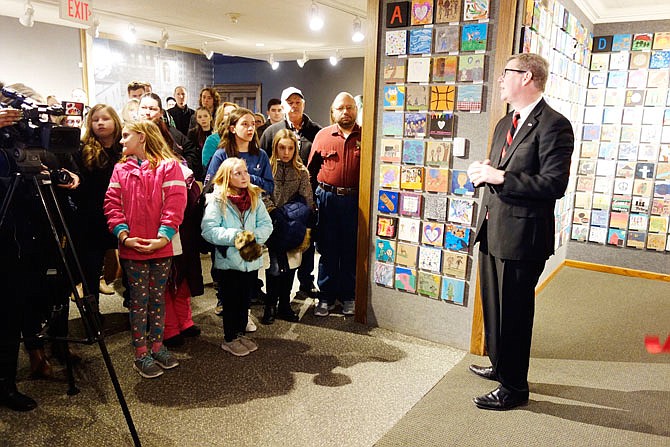Thousands of hours came down to the moment when student Estella VanSchenkhof put her fingers on a keyboard Tuesday morning and looked at her own creation.
Her picture for the National Churchill Museum's newly unveiled Special Relationship Project: A yellow tulip.
"My little dog died, and I put a yellow tulip on his grave," said the fifth-grade girl from McIntire Elementary School. "His name was Willow."
It's those special relationships that bring meaning to life and became the point of the project. More than 4,000 school children in Callaway County, plus a few others, created a piece of heartfelt art on a 6-by-6-inch canvas provided by museum officials.
The project was spearheaded by Tyler Oberlag, manager of Guest Services and Museum Operations, and Tim Riley, director and chief curator.
When the hanging of the exhibition had barely begun, Riley predicted it would be as colorful as a candy shop. But it's more than bright colors, Oberlag said.
"There are descriptions on the website (written by each student), and when you read their statements, you think, 'Wow - this is really deep,'" he added. "They're not just pictures."
Riley said the idea for the exhibition came, in part, from Debbie LaRue, a vice president of The Callaway Bank and director of Market, Public Relations, and The Callaway Kids Bank. Riley said she had made a comment about getting children involved to create awareness.
"I'm just so pleased that our children became involved," she said at Tuesday's grand opening of the exhibition.
Riley and Oberlag put their brains together. Realizing just how important the term "special relationship," coined by Sir Winston Churchill during his 1946 Fulton visit, they decided to ask children in Callaway County what they considered to be their own special relationships.
"The Fulton community isn't always aware of our story," Oberlag said of the National Churchill Museum. "What Tim and I wanted to do was find a way to get the community involved."
The idea of the exhibition, which will hang until September, was born.
"I thought this was really cool," Oberlag added. "I thought, 'I can pull this off.'"
Last July, they met with local school superintendents. With their support, Riley made the announcement in early August at the Callaway Chamber of Commerce's inaugural Teacher Appreciation Breakfast. They started collecting the blank canvases and delivering them to schools.
"From October to December, the students were working on their canvases, and in December, they started coming back to the museum," Oberlag said.
Each canvas was accompanied by the student artist's description, labeled and scanned, and entered into a website (ancmsrp.org). Volunteers, including members of The Callaway Kids Bank, helped with the computer work and careful hanging of each of the 4,000 pieces of art.
On Tuesday, the exhibition opened at the museum with a ribbon cutting and groups of students.
"I feel relieved," Oberlag said. "I'm excited about the turn out."
The date of the opening was no accident. On March 5, 1946, the former British Prime Minister Churchill gave his famous "Iron Curtain Speech" at Westminster College, in the presence of President Harry Truman. He warned of a cold war brewing between America and Soviet Russia, and also spoke of the special relationship shared between the U.S. and Britain.
"What we've done is to ask every student in Callaway County to describe what special relationship means to them," Riley said. "It takes an entire community to do this."
Riley also announced a recent $35,000 donation by the Mid-Missouri Friends of the National Churchill Museum Board to help with upkeep of the museum's shining star, a 1670s, Christopher Wren-designed church. The Church of St. Mary the Virgin, Aldermanbury, was one of several bombed into rubble by Nazi Germany pilots in World War II.
Past Westminster College President Robert Davidson's daughter, Roberta Cupp, in attendance Tuesday, described how this former London church arrived in Fulton.
"Churchill had been here to speak at the college," she said. "The (Swope) Chapel was needing to be replaced, and he saw in Life magazine pictures of churches that had been bombed (in England), and he started thinking."
He also started raising the $2 million needed to bring the church to Fulton. It took four years to secure permission from the British Church and State. In 1965, with each stone carefully numbered, 700 tons of blocks were shipped to Virginia free of charge as ballast. Then they came to Fulton by rail, and the foundation stone was laid in October 1966. Three years later, the National Churchill Museum opened.
While there will be 50th anniversary events throughout 2019 including a 30th anniversary of the Berlin Wall sculpture "Breakthrough" in November, a huge weekend is planned May 3-5 (read the Fulton Sun article: bit.ly/2Rzh4Mh). Tuesday's exhibition opening was just the beginning, Riley said.
"So many people come here from all over the world, but our children don't know about the museum," LaRue said.
"And now the world will know about our children," Riley added.

